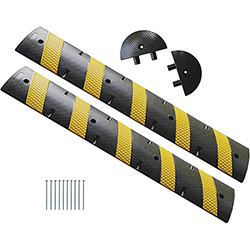Introduction
Traffic calming devices are essential tools in regulating vehicle speeds on our streets and highways. One of these devices is the speed table, an effective measure to reduce speed and improve road safety. In this article, we will focus on the benefits and challenges of using speed tables in traffic regulation. We will explore its definition, operation and its impact on road safety and the environment. We will also talk about successful examples of its implementation and important considerations when using this device. Our objective is to highlight the importance of this device and promote its implementation on more roads to improve the safety of drivers and pedestrians.
What are speed tables?
Speed tables, also known as “speed tables”, are traffic calming devices used to reduce the speed of vehicles in urban areas. Unlike other devices like speed humps, speed tables are longer and have a height of 3-3.5 inches and a length of 22 feet. These features allow the vehicle to pass over them more smoothly and at a lower speed.
Speed tables work by raising the entire distance between the vehicle’s wheels, forcing the driver to reduce their speed to pass over them. These are an effective tool to control traffic and improve road safety in areas with heavy traffic or where high speeds are recorded.
Compared to other traffic calming devices, speed tables have proven to be more effective in reducing vehicle speed and preventing accidents. They are also better suited for areas with emergency traffic, as they allow emergency vehicles to pass through without interruption.
Benefits of using speed tables
The implementation of speed tables on roads is an effective strategy to reduce traffic speed and improve road safety. Some of the most important benefits of using this traffic calming device are:
- Safety for drivers and pedestrians: Speed tables force drivers to reduce their speed, which reduces the risk of accidents and injuries for both them and pedestrians crossing the street.< /li>
- Reduction of gas and noise emissions: By reducing the speed of vehicles, speed tables also contribute to a reduction in air and noise pollution in urban areas.
- Proven effectiveness: Studies have shown that speed tables are more effective than other traffic calming devices, such as speed humps, in reducing vehicle speeds and improving road safety.< /li>
In summary, the implementation of speed tables on roads offers a series of benefits for both drivers and pedestrians, as well as for the environment. Despite the possible challenges in its installation, it is important to consider this tool as an effective option in traffic regulation in urban areas.
Challenges of implementing speed tables
Despite the numerous benefits of using speed tables in traffic regulation, their implementation can also present some challenges. One of the main challenges is the limitation of space in some urban areas, especially on narrow or busy roads. Additionally, there may be community resistance to installing these devices due to concerns about the impact on traffic or street appearance.
It is important to have a proper design when installing speed tables to ensure that they do not impede emergency traffic or drainage maintenance. It is also essential to consider the opinion of residents and work together to find solutions that work for everyone. Proper planning and continuous evaluation are key to overcoming these challenges and achieving a successful implementation of speed tables in a community.
- Have an appropriate design so as not to impede emergency traffic and drainage maintenance.
- Consider community input and work together to find solutions.
- Conduct appropriate planning and continuous evaluation to ensure successful implementation.
In summary, although there are challenges in implementing speed tables, these can be overcome with proper planning and effective collaboration with the community. It is important to address these challenges to take full advantage of the road safety and environmental benefits that this traffic calming device offers. Together we can make our roads safer!

